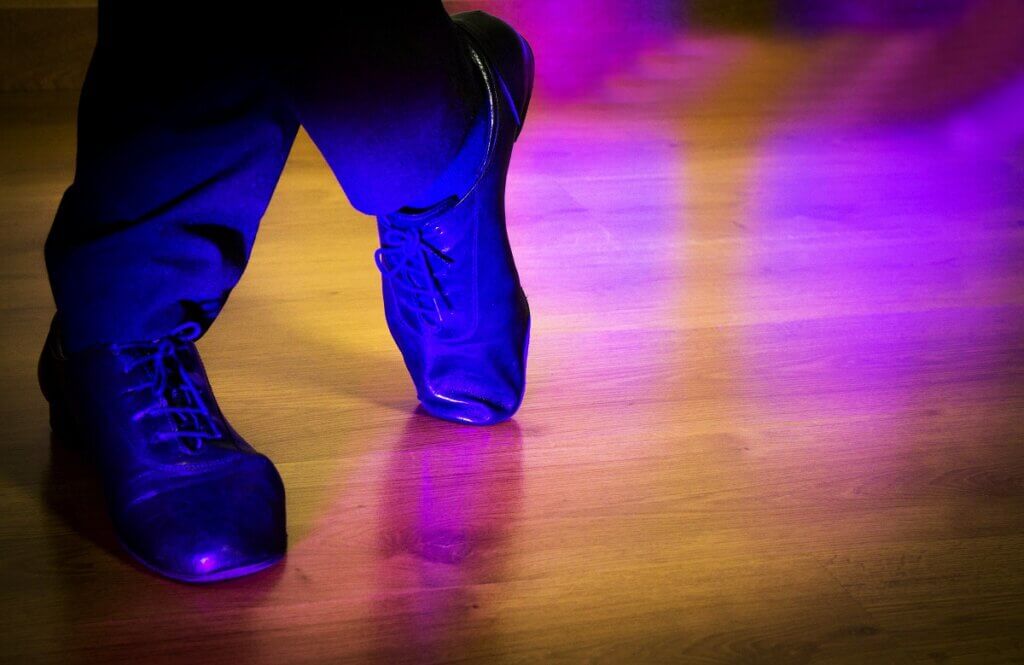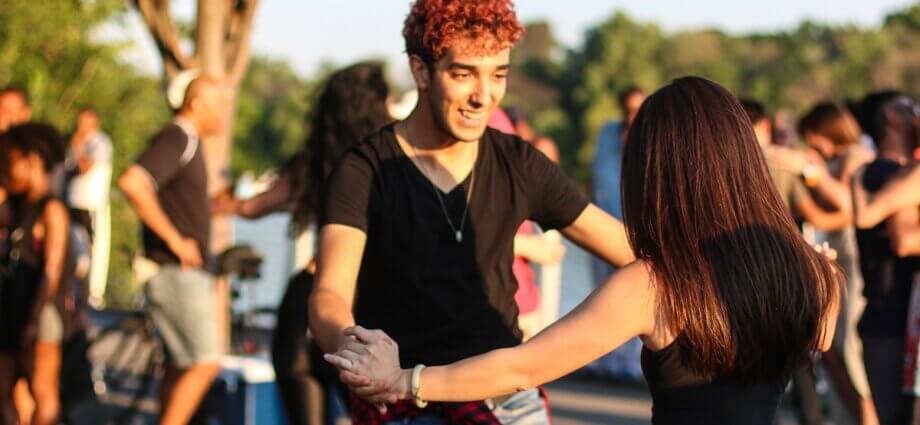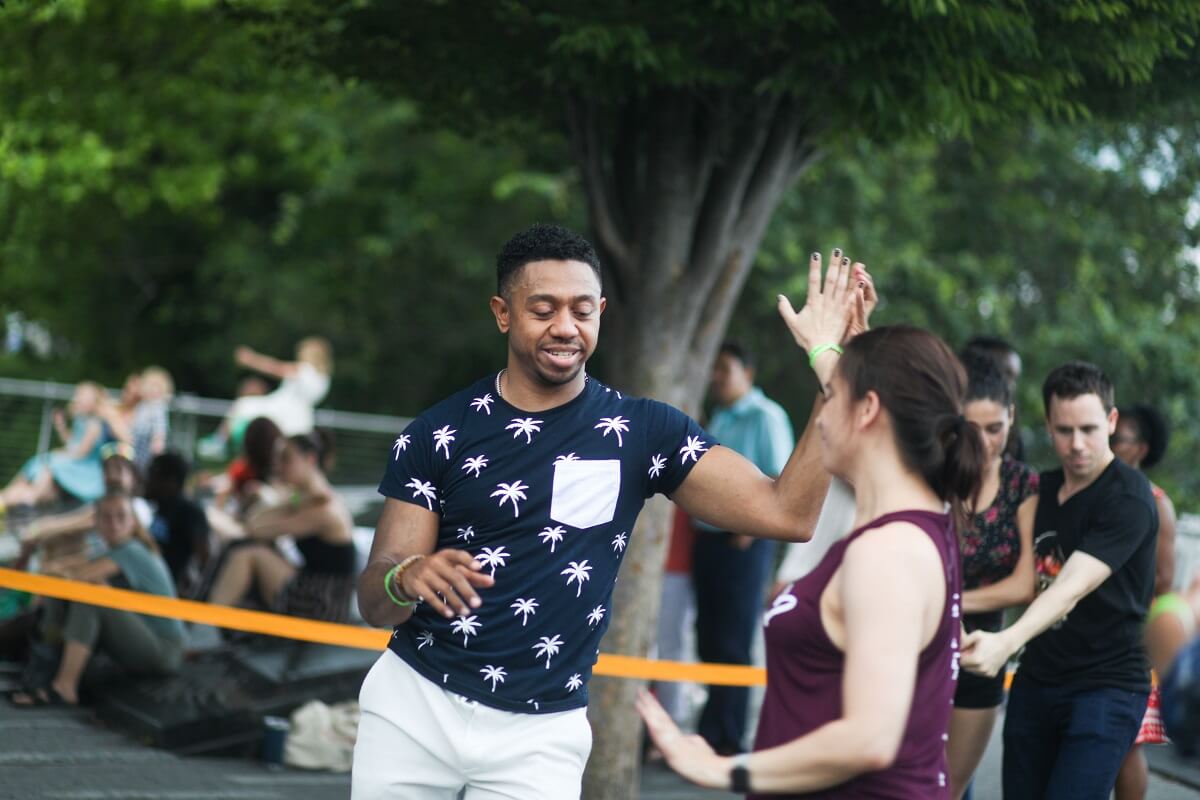Here’s a terrible stereotype for you: Dominican bachata is all about fast footwork. It’s terrible because not only does it make the dance seem scary, but it’s also incorrect. There’s far more to Dominican bachata than just footwork. And sometimes, there’s really not much footwork at all.
Let’s take a look at when to do footwork in Dominican bachata, when you should keep it simple, and why. We’ll also break down some bachata songs to help you put all this into practice at home.
Dominican Bachata Isn’t About Fast Footwork
Dominican bachata is about musicality, connection, attitude, and body movement. As a street dance rather than a studio dance, the most impressive thing is the flow or sabor. This means it’s not technically sound footwork that makes a bachata dancer look great. It’s when and how they use use that footwork.
Footwork can be used to reflect what’s happening in the music, especially in certain parts of the bachata song. Take a look at how Cristian & Katerina use their footwork to accentuate the music in this after-class demo:
Yet this isn’t the only way to dance Dominican bachata with musicality and style. While Kimberly Ramos of Araguacu Latin Dance Company uses some footwork and syncopations in this demo, she’s mainly playing with her basic steps—and they are as impressive, flavourful, and fun as her footwork.
Footwork is one tool in the Dominican bachata dancer’s repertoire, but it’s certainly not the only one. And if you hit every syncopation, your footwork can become underwhelming.
Why Dominican Bachata Music Makes You Want to Syncopate More
If you’re used to dancing bachata moderna or sensual bachata, then you’ve probably been taught to hit syncopations when they are the most prominent thing you hear in the music. It might be with footwork, sharp body movement, or even arm styling, but no matter how you do it, the goal is the same: to illustrate what’s happening in the music.
But this isn’t because you should hit every single syncopation in the song. It’s because the various instruments aren’t always as obvious in the music to which we dance bachata moderna and sensual. When an instrument, rhythm, or beat is the main thing you hear, it’s purposeful.
Bachata started life as party music played by a band. This meant the five principal instruments (three guitars, two percussion-based ones) were easy to hear. Every strum of a guitar and every beat of the bongos became part of the sound of the song—even when the vocals were supposed to be the focal point.
Yet over time, as bachata moved to the recording studio and the DJ deck, new instruments and musical influences came into play. The melody became stronger, while songs began borrowing from pop, R&B, hip hop, tango, and more. As a result, the distinct rhythms played by the bachata instruments, while still necessary for a song to be bachata, aren’t always centre-stage in today’s bachata songs. Compare these two tracks, for example:
“Margarita” by Raulín Rodríguez
“Entre Los Dos” by SP Polanco, feat. Karlos Rosé
In “Entre Los Dos”, it’s easy to identify the moments for sensual or non-traditional bachata movements (e.g. the long intro and the outro), footwork (from 3:00), and your standard bachata moves. Meanwhile, in “Margarita”, our attention is drawn to all the different instruments. If you’re not used to this style of bachata, it can be harder to distinguish when the song is calling for us to do footwork and when we can relax.
More traditional-sounding bachata music can feel busy. You hear far more of the instruments, even the ones that aren’t necessarily leading the song, and this in turn makes you want to syncopate more. But that’s not always a good thing.
When Should You Do Fast Footwork? A Quick Bachata Musicality Class
Dancing needs variety to be interesting, both for the dancers and anyone watching. Fortunately, bachata music naturally includes plenty of variety in the structure, rhythms, and energy. As dancers, you can match that with your movement to create a more interesting and musical experience.
When you do lots of footwork or syncopations, you are dancing with high levels of energy and expression. Think of it as dancing at levels 8–10 out of 10. This means that you want to do this during the most high-energy, explosive part of the song.
If you dance at level eight during the quiet parts of the song, you can only go up two levels during the high-energy sections—and that’s barely going to be noticeable. Plus, you and your partner will likely be pretty worn out by the time the song ends.
This doesn’t mean that you can’t do any footwork during other parts of the song. You can add footwork and syncopations to most sections of the music, but you want to save your all-out, intense footwork for the intense part of the bachata song. And that’s called the mambo.

Bachata songs can be divided into three main parts, in addition to the intros, outros, and musical interludes that borrow from other musical genres. These three are:
- The derecho: this is the most tranquil part. The lyrics will likely demand your attention, and you’ll probably find yourself dancing smaller movements and relaxing into the song.
- The majao: this is a higher-energy section, and it’s often the song’s chorus. It should make you want to dance with more enthusiasm. Even if the song is sad, you might find yourself smiling here. Don’t allow yourself to be misled by how many beats of an instrument there are. For example, the güira is struck fewer times per count in the majao than in the derecho, but it’s done with more energy here.
- The mambo: this is when the instruments are in the spotlight. There will be no vocals, and the lead guitar or requinto will literally lead the song. This is the time to play with fast footwork.
Of course, even within the derecho and the majao, you’ll notice smaller variations in energy. There’s often a slight change in the music after every 28 or 32 beats, and you’ll notice the instruments building up to this. And even within our 8-beat counts, you can often trace a change in the energy. Overall, however, these are subtler when compared with the differences between the derecho, majao, and mambo.
If you’re not used to traditional bachata music, you might struggle to identify these sections. Even a derecho can seem more instrumental than a sensual bachata’s mambo. Let’s break it down with some examples, traditional and modern.
“Soy Mía” by Natti Natasha
In this powerful, feminist song, the first derecho starts at around 0:15. It switches to the majao at around 0:55. The mambo, meanwhile, appears at around 2:35. While there aren’t any lyrics at this point, Natti Natasha briefly speaks over the mambo, saying “llora, guitarra, llora” or “cry, guitar, cry”. It’s a direct invitation to the requinto to go all out. Now see if you can work out when the other switches happen.
“Su lado de cama” by Joan Soriano
This romantic love song goes straight into a calm derecho, while the first majao comes in at roughly 1:15—the moment that, even in the video, they can’t resist dancing. The mambo starts at 2:19 before switching back to a derecho at 2:45. Again, see if you can identify the other switches.
How to Practise Footwork in Dominican Bachata
We’ve looked at the musical theory behind when you should do footwork. Now, it’s time to put it into practice. Try this drill to help you:
- Listen to a song a couple of times. Even though it might be tempting, don’t dance to it just yet.
- Now, dance to the song without any syncopations. You might prefer to stick to variations of the basic step. Pay attention to the changes in energy, and see if you can work out where the mambo is, where the breaks are, and where the song feels mellower.
- Optionally, listen to the song again without dancing.
- Add minimal amounts of footwork as you dance to the song, focusing on the mambo and breaks.
- Repeat stage 4, introducing more footwork as you feel is appropriate. Remember, however, that when the song is calm, you can relax. Either keep that footwork low-key or save it for the moments when the music calls for energy.
- Pick a new song, and repeat.
Remember, achieving good musicality—just like achieving clean, fast footwork—doesn’t happen overnight. It takes time and practice to hone this skill. As well as this exercise, you can download the Bachata Musicality app to help you recognise the different rhythms and practise with resources like Bachata Breakdown ¡En Vivo! and eMusicality. Look for teachers who prioritise musicality, such as Carlos Cinta, Kimberly Ramos in Toronto, and Pierre Henry in London.
Done well, fast footwork is fun and impressive—but there’s no need to exhaust yourself. Dominican bachata can also be relaxed, sensual, or full of emotion. Just listen to the music and enjoy yourself.
Feature photo credit: Nicole Glass Photography / Shutterstock.com

Ella Baila
Ella Baila is a bachata and salsa teacher by night, social worker by day. She dabbles in most Afro-Latin dances and would like to try blues.






